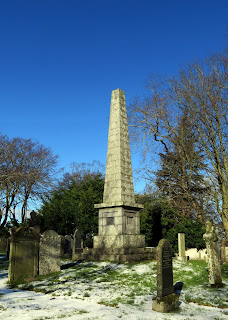 |
| Crimond Kirkyard is situated a little under a mile to the north of the village - close to the Loch of Strathbeg, partly sheltered and surrounded by trees, but with farmland, 'weel vrocht grun' and open countryside sweeping over towards Mormond Hill .  |
 |
| The imposing ivy clad gateposts |
 |
| The armorial panel in the right hand gate post |
 |
| The gate posts are both topped by two stone balusters and a triangular panel which support a spike finial thought to be from an earlier belfry. |
 | |
|
 |
| This gravestone, probably actually a flat grave slab, has been repositioned vertically close to the kirkyard dyke so that the death's head symbol and lettering are upside down. |
 |
| This granite obelisk is a smaller version of a monument at Crimonmogate commemorating Sir Charles Bannerman and his family. Sir Charles died in 1851, having inherited the estate from his relative Patrick Milne, who was for a time MP for the Elgin burghs. |
 |
| Snowdrops, Victorian symbols of purity, in the kirkyard |
 |
| The present Parish Church in the village was built in 1812, the psalm tune Crimond was composed by Jessie Seymour Irvine 1836 - 1886, daughter of a Crimond minister. |





No comments:
Post a Comment